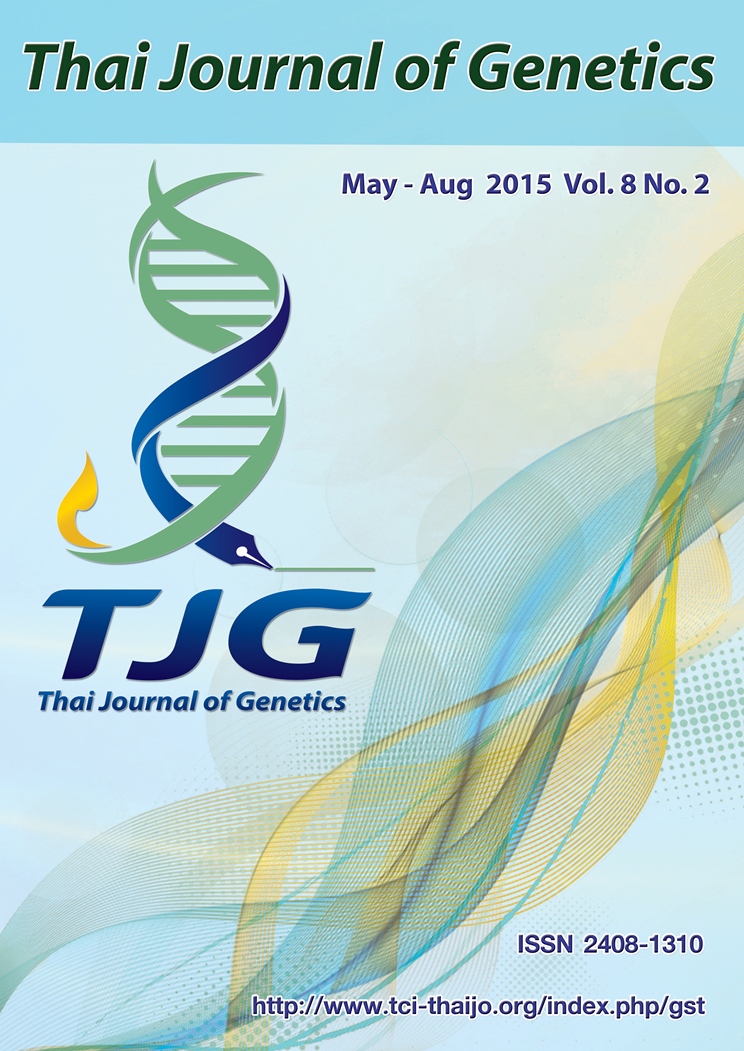การวิเคราะห์โครงสร้างทางพันธุกรรมของประชากรชาวไทยอีสาน จังหวัดบุรีรัมย์ ด้วยไมโครแซเทลไลท์บนออโตโซม (Genetic structure of the Thai-Isan from Buriram Province as revealed by autosomal microsatellites analysis)
DOI:
https://doi.org/10.14456/tjg.2015.13Keywords:
ไทยอีสาน (Thai-Isan), ไมโครแซเทลไลท์ (microsatellite), โครงสร้างทางพันธุกรรม (genetic structure), กระได (Kra-Dai), ออสโตรเอเชียติค (Austroasiatic)Abstract
ชาวไทยอีสานเป็นกลุ่มชาติพันธุ์ขนาดใหญ่ที่สุด อาศัยอยู่ในภาคตะวันออกเฉียงเหนือของประเทศไทย ชาวไทยอีสานอพยพมาจากประเทศลาวในระหว่างศตวรรษที่ 14 ถึง 18 งานวิจัยที่ผ่านมาได้มีการศึกษาพันธุกรรมของชาวไทยอีสาน แต่อาศัยเพียงดีเอ็นเอไมโทคอนเดรียเป็นเครื่องหมายทางพันธุกรรม งานวิจัยนี้จึงต้องการขยายการศึกษาโครงสร้างทางพันธุกรรมของชาวไทยอีสาน จำนวน 53 คน จากจังหวัดบุรีรัมย์ ด้วยไมโครแซเทลไลท์บนออโทโซมจำนวน 15 ตำแหน่ง คือ D8S1179 D21S11 D7S820 CSF1PO D3S1358 THO1 D13S317 D16S539 vWA TPOX D18S51 D5S818 FGA D19S433 และ D2S1338 ผลการศึกษาพบว่าประชากรที่ศึกษามีความหลากหลายทางพันธุกรรมสูง (จำนวนอัลลีลทั้งหมด 122 อัลลีล และ ความหลากหลายของยีน = 0.7094±0.4406) เมื่อวิเคราะห์ความสัมพันธ์ระหว่างประชากร โดยนำประชากรอื่นที่อยู่ในภาคตะวันออกเฉียงเหนือของประเทศไทยมาเปรียบเทียบ พบว่าชาวไทยอีสาน จังหวัดบุรีรัมย์ มีความใกล้ชิดทางเชื้อสายกับชาวไทยอีสาน จังหวัดร้อยเอ็ด และชาวไทยอีสานทั้งสองประชากรแสดงลักษณะทางพันธุกรรมของประชากรลูกผสม เนื่องจากมีตำแหน่งอยู่กึ่งกลางระหว่างประชากรอื่นในแผนภูมิต้นไม้แสดงความสัมพันธ์ทางวิวัฒนาการและแผนภูมิ multidimensional scaling เมื่อคำนวณสัดส่วนการผสมผสานทางพันธุกรรมของประชากรพบว่า ชาวไทยอีสาน จังหวัดบุรีรัมย์ ได้รับสัดส่วนทางพันธุกรรมจากประชากรพ่อแม่ที่พูดภาษาตระกูลกระได (กะเลิง และญ้อ) ร้อยละ 65 มากกว่าประชากรที่พูดภาษาตระกูลออสโตรเอเชียติค (ชาวบน เขมร และส่วย) ร้อยละ 35
References
Babiker HM, Schlebusch CM, Hassan HY, Jakobsson M (2011) Genetic variation and population structure of Sudanese populations as indicated by 15 Identifiler sequence-tagged repeat (STR) loci. Investig Genet 2: 12.
Belle EM, Landry PA, Barbujani G (2006) Origins and evolution of the Europeans’ genome: evidence from multiple microsatellite loci. Proc R Soc B Biol Sci 273: 1595–1602.
Bertorelle G, Excoffier L (1998) Inferring admixture proportions from molecular data. Mol Biol Evol 15: 1298–1311.
Boonsoda P, Srithawong S, Srikuka S, Kutanan W (2013) Mitochondrial DNA variation of the Khmer in Surin Province. Thai J Genet 6: 40–48.
Crossetti SG, Demarchi DA, Raimann PE, Salzano FM, Hutz MH, Callegari-Jacques SM (2008) Autosomal STR genetic variability in the Gran Chaco native population: Homogeneity or heterogeneity?. Am J Hum Biol Off Hum Biol Counc 20: 704–711.
Di Benedetto G, Ergüven A, Stenico M, Castrì L, Bertorelle G, Togan I, Barbujani G (2001) DNA diversity and population admixture in Anatolia. Am J Phys Anthropol 115: 144–156.
Dupanloup I, Bertorelle G (2001) Inferring admixture proportions from molecular data: extension to any number of parental populations. Mol Biol Evol 18: 672–675.
Earl DA, vonHoldt BM (2011) STRUCTURE HARVESTER: a website and program for visualizing STRUCTURE output and implementing the Evanno method. Conserv Genet Resour 4: 359–361.
Evanno G, Regnaut S, Goudet J (2005) Detecting the number of clusters of individuals using the software STRUCTURE: a simulation study. Mol Ecol 14: 2611–2620.
Excoffier L, Lischer HEL (2010) Arlequin suite ver 3.5: a new series of programs to perform population genetics analyses under Linux and Windows. Mol Ecol Resour 10: 564–567.
Falush D, Stephens M, Pritchard JK (2003) Inference of population structure using multilocus genotype data: linked loci and correlated allele frequencies. Genetics 164: 1567–1587.
Gaibar M, Esteban E, Moral P, Gómez-Gallego F, Santiago C, Bandrés F, Luna F, Fernández-Santander A (2010) STR genetic diversity in a Mediterranean population from the south of the Iberian Peninsula. Ann Hum Biol 37: 253–266.
Hubisz MJ, Falush D, Stephens M, Pritchard JK (2009) Inferring weak population structure with the assistance of sample group information. Mol Ecol Resour 9: 1322–1332.
Kayser M (2007) Uni-parenral marker in parental identity testing including forensic DNA analysis. Biotechniques 43(6): S16–S21.
Keyes CF (1988) Isan: Regionalism in Northeastern Thailand. Dalley Book Service.
Khanittanan W (2001) Khmero-Thai: The great change in the history of Thai language in the Chao Praya basin. Journal of Language and Linguistics 19: 35–50.
Kraaijenbrink T, van der Gaag KJ, Zuniga SB, Xue Y, Carvalho-Silva DR, Tyler-Smith C, Jobling MA, Parkin EJ, Su B, Shi H, et al. (2014) A Linguistically Informed Autosomal STR Survey of Human Populations Residing in the Greater Himalayan Region. PLoS ONE 9: e91534.
Kutanan W, Kampuansai J, Colonna V, Nakbunlung S, Lertvicha P, Seielstad M, Bertorelle G, Kangwanpong D (2011a) Genetic affinity and admixture of northern Thai people along their migration route in northern Thailand: evidence from autosomal STR loci. J Hum Genet. 56: 130–137.
Kutanan W, Kampuansai J, Fuselli S, Nakbunlung S, Seielstad M, Bertorelle G, Kangwanpong D (2011b) Genetic structure of the Mon-Khmer speaking groups and their affinity to the neighbouring Tai populations in Northern Thailand. BMC Genet 12: 56.
Kutanan W, Ghirotto S, Bertorelle G, Srithawong S, Srithongdaeng K, Pontham N, Kangwanpong D (2014a) Geography has more influence than language on maternal genetic structure of various northeastern Thai ethnicities. J Hum Genet 59: 512–520.
Kutanan W, Srithawong S, Kamlao A, Kampuansai J (2014b) Mitochondrial DNA-HVR1 Variation Reveals Genetic Heterogeneity in Thai-Isan Peoples from the Lower Region of Northeastern Thailand. Adv Anthropol 4: 7–12.
Lewis MP (2009) Ethnologue: Languages of the World. 16th ed. SIL International, Dallas.
Listman JB, Malison RT, Sughondhabirom A, Yang BZ, Raaum RL, Thavichachart N, Sanichwankul K, Kranzler HR, Tangwonchai S, Mutirangura A, et al. (2007) Demographic changes and marker properties affect detection of human population differentiation. BMC Genet 8: 21.
Nei M (1987) Molecular Evolutionary Genetics. Columbia University Press, New York.
Pritchard JK, Stephens M, Donnelly P (2000) Inference of population structure using multilocus genotype data. Genetics 155: 945–959.
Smalley WA (1988) Multilingualism in the Northern Khmer population of Thailand. Lang Sci 10: 395–408.
Smalley WA (1994) Linguistic diversity and national unity: language ecology in Thailand. University of Chicago Press, Chicago.
Srithawong S, Srikummool M, Pittayaporn P, Ghirotto S, Chantawannakul P, Sun J, Eisenberg A, Chakraborty R, Kutanan W (2015) Genetic and linguistic correlation of the Kra–Dai-speaking groups in Thailand. J Hum Genet 60: 371–380.
Talbot S, Chutima J (2001) Northeast Thailand before Angkor: Evidence from an Archaeological Excavation at the Prasat Hin Phimai. Asian Perspect 40: 179–194.
Tamura K, Peterson D, Peterson N, Stecher G, Nei M, Kumar S (2011) MEGA5: molecular evolutionary genetics analysis using maximum likelihood, evolutionary distance, and maximum parsimony methods. Mol Biol Evol 28: 2731–2739.
Vail P (2007) Thailand’s Khmer as “invisible minority”: Language, ethnicity and cultural politics in north-eastern Thailand. Asian Ethn 8: 111–130.
Welch DJ (1998) Archaeology of Northeast Thailand in Relation to the Pre-Khmer and Khmer Historical Records. Int J Hist Archaeol 2: 205–233.
Wyatt DK (2003) Thailand: A Short History. 2nd ed. Yale University Press, New Haven.



